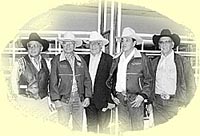|
Aboriginal cowboys have always competed alongside non-Native cowboys in rodeos. However, as in many sports in which judges subjectively determine the quality of a performance, feelings of discrimination often arose. Some Aboriginal people began to feel that they were not being fairly judged by the rodeo committee and judges because of their Native ancestry. In the 1950s and 1960s, therefore, Native cowboys began organizing their own rodeo clubs, with their own committees and judges. These Aboriginal (Indian) rodeo associations, established in both Canada and the United States, provided another venue for Native competitors. Today, there are five Native Plains and Plateau rodeo associations in Canada and over 20 in the United States. They organize rodeos, rodeo schools, clinics, and youth activities to encourage young people to become athletes by helping them set goals and teaching them to be responsible for themselves and their animals. In 1974, several Indian rodeo association organizers in Canada and the United States formed an association that would host international Indian rodeo finals. It came to be known as the Indian National Finals Rodeo (INFR) Commission, and its first members were Pete and John Fredricks, Jay Harwood, Mel Samson and Fred Gladstone. In 1975, the first world Indian rodeo finals were held in Salt Lake City, Utah. Only thirteen Indian rodeo associations in Canada and the United States are recognized by the Commission. They are the only ones allowed to participate in Indian National Finals rodeos. . . . I like rodeo. It's part of our family's tradition to all be involved in rodeo. I like to start up the younger generation to get into rodeo because it keeps them out of trouble . . . It takes a lot of work to keep a horse in good shape. Rodeo teaches kids how to care for horses and horsemanship. This keeps a lot of kids out of trouble. Merle Yellowbird, Samson Reserve, Hobbema, Alberta, 1994 Introduction | What makes Native Rodeo Different? | History of Rodeo Associations | Rodeo Heroes | The Rodeo Arena | The Rodeo Circuit | Rodeo Events | Down the Road SACRED BEINGS | RANCHING | ENTERTAINMENT | RODEO | ARTS AND INDUSTRIES |

